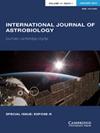Mars: new insights and unresolved questions
IF 1
4区 物理与天体物理
Q3 ASTRONOMY & ASTROPHYSICS
引用次数: 23
Abstract
Mars exploration motivates the search for extraterrestrial life, the development of space technologies, and the design of human missions and habitations. Here, we seek new insights and pose unresolved questions relating to the natural history of Mars, habitability, robotic and human exploration, planetary protection, and the impacts on human society. Key observations and findings include: – high escape rates of early Mars' atmosphere, including loss of water, impact present-day habitability; – putative fossils on Mars will likely be ambiguous biomarkers for life; – microbial contamination resulting from human habitation is unavoidable; and – based on Mars' current planetary protection category, robotic payload(s) should characterize the local martian environment for any life-forms prior to human habitation. Some of the outstanding questions are: – which interpretation of the hemispheric dichotomy of the planet is correct; – to what degree did deep-penetrating faults transport subsurface liquids to Mars' surface; – in what abundance are carbonates formed by atmospheric processes; – what properties of martian meteorites could be used to constrain their source locations; – the origin(s) of organic macromolecules; – was/is Mars inhabited; – how can missions designed to uncover microbial activity in the subsurface eliminate potential false positives caused by microbial contaminants from Earth; – how can we ensure that humans and microbes form a stable and benign biosphere; and – should humans relate to putative extraterrestrial life from a biocentric viewpoint (preservation of all biology), or anthropocentric viewpoint of expanding habitation of space? Studies of Mars' evolution can shed light on the habitability of extrasolar planets. In addition, Mars exploration can drive future policy developments and confirm (or put into question) the feasibility and/or extent of human habitability of space.火星:新的见解和未解决的问题
火星探索推动了对地外生命的探索,空间技术的发展,以及人类任务和居住地的设计。在这里,我们寻求新的见解,并提出有关火星自然历史、可居住性、机器人和人类探索、行星保护以及对人类社会的影响等尚未解决的问题。主要观察和发现包括:早期火星大气的高逃逸率,包括水的损失,影响了今天的宜居性;-火星上假定的化石可能是生命的模糊生物标志物;-人类居住造成的微生物污染是不可避免的;根据火星目前的行星保护类别,在人类居住之前,机器人有效载荷应该表征火星当地任何生命形式的环境。一些悬而未决的问题是:-对地球半球二分法的哪种解释是正确的;-深穿透断层在多大程度上将地下液体输送到火星表面;-由大气过程形成的碳酸盐的丰度;-火星陨石的哪些特性可以用来限制它们的来源位置;-有机大分子的来源;-火星是否有人居住;-旨在揭示地下微生物活动的任务如何消除由地球微生物污染物造成的潜在误报;——如何确保人与微生物形成稳定、良性的生物圈;人类应该从生物中心(保护所有生物)的角度来看待假定的外星生命,还是从人类中心(扩大空间居住)的角度来看待?对火星演化的研究可以揭示太阳系外行星的宜居性。此外,火星探索可以推动未来的政策发展,并确认(或质疑)人类在太空居住的可行性和/或程度。
本文章由计算机程序翻译,如有差异,请以英文原文为准。
求助全文
约1分钟内获得全文
求助全文
来源期刊

International Journal of Astrobiology
地学天文-地球科学综合
CiteScore
3.70
自引率
11.80%
发文量
45
审稿时长
>12 weeks
期刊介绍:
International Journal of Astrobiology is the peer-reviewed forum for practitioners in this exciting interdisciplinary field. Coverage includes cosmic prebiotic chemistry, planetary evolution, the search for planetary systems and habitable zones, extremophile biology and experimental simulation of extraterrestrial environments, Mars as an abode of life, life detection in our solar system and beyond, the search for extraterrestrial intelligence, the history of the science of astrobiology, as well as societal and educational aspects of astrobiology. Occasionally an issue of the journal is devoted to the keynote plenary research papers from an international meeting. A notable feature of the journal is the global distribution of its authors.
 求助内容:
求助内容: 应助结果提醒方式:
应助结果提醒方式:


